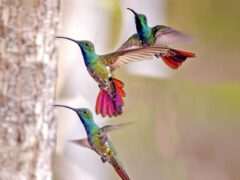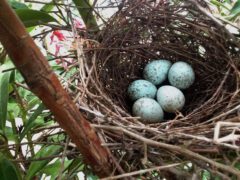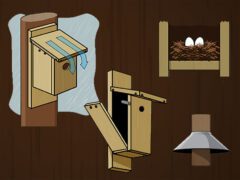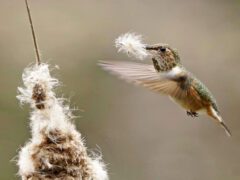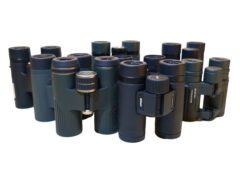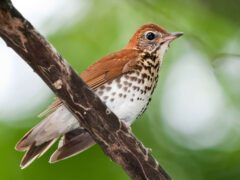Costa's Hummingbird Similar Species Comparison
Main SpeciesCosta's Hummingbird
Adult male
Small and compact hummingbird with a hunched posture and a short tail. The male's iridescent purple gorget (throat patch) flares out along the sides of the neck like an overgrown mustache.
© Gordon Karre / Macaulay LibraryArizona, February 06, 2017Female
When perched the wings barely extend beyond the tail on this tiny, compact hummingbird. Females are greenish above with a white eyebrow stripe, a grayish cheek patch, and whitish underparts.
© Gordon Karre / Macaulay LibraryArizona, January 29, 2020Adult male
Gorget color is dark purple, and feathers extend off the sides of the throat. Fairly short wings; wingtips barely extend past the tail.
© Benjamin Clock / Macaulay LibraryCalifornia, March 22, 2013Adult male
Males repeatedly perch at 3–4 favorite spots within their territory, usually a dead twig in a palo verde, acacia, or ironwood, and sing a thin high-pitched whistle to proclaim ownership and keep intruders out.
© Christopher Lindsey / Macaulay LibraryCalifornia, March 31, 2020Immature male
Immature males have variable amounts of adult gorget feathers coming in on the neck. Note whitish underparts and green washing on the sides.
© Brian Sullivan / Macaulay LibraryCalifornia, December 23, 2020Female
A compact hummingbird. When perched, its wings barely extend beyond the tail. Females are greenish above with a white eyebrow stripe and a grayish cheek patch.
© Herb Elliott / Macaulay LibraryArizona, December 28, 2016Adult male
Found in desert scrub in the Sonoran and Mojave Deserts, and chaparral and sage scrub areas in coastal California where they drink nectar from many desert plants, especially chuparosa and ocotillo.
© James Taylor / Macaulay LibraryArizona, February 22, 2018Similar SpeciesAnna's Hummingbird
Adult male
Anna's Hummingbirds, are larger with a less hunched posture than Costa's. When perched, the tail of Anna's extends farther past the wings than it does on Costa's Hummingbirds. The gorget and crown on male Anna's shines red rather than purple.
© Kyle Blaney / Macaulay LibraryCalifornia, March 02, 2013Similar SpeciesAnna's Hummingbird
Female/immature male
Female/immature Anna's Hummingbirds often have red feathers in the center of their throats that female/juvenile Costa's lack.
© Ryan O'Donnell / Macaulay LibraryWashington, December 31, 2016Similar SpeciesBlack-chinned Hummingbird
Adult male
Black-chinned Hummingbirds are slightly larger than Costa's with a more elongated posture and a longer bill. Males have a very dark purple throat that often looks black and they don't have the overgrown mustache look of Costa's Hummingbirds.
© Ian Hearn / Macaulay LibraryIdaho, July 13, 2017Similar SpeciesBlack-chinned Hummingbird
Female/immature
Female/immature Black-chinned Hummingbirds have a longer bill than Costa's and a little bit of peachy color on their flanks that female/immature Costa's lack.
© Paul Fenwick / Macaulay LibraryCalifornia, September 14, 2016Similar SpeciesCalliope Hummingbird
Adult male
Calliope Hummingbirds are smaller than Costa's with a streaky pink throat unlike adult male Costa's which have a solid purple throat.
© Marya Moosman / Macaulay LibraryIdaho, May 26, 2015Similar SpeciesCalliope Hummingbird
Female/immature
Female/immature Calliope Hummingbirds have peached wash flanks unlike female/immature Costa's Hummingbirds which have grayish flanks.
© Jesse Amesbury / Macaulay LibraryNew Jersey, November 09, 2015Similar SpeciesBroad-tailed Hummingbird
Adult male
Adult male Broad-tailed Hummingbirds have a rosy throat while adult male Costa's have a flared purple throat patch.
© Gregg Friesen / Macaulay LibraryColorado, July 29, 2017Similar SpeciesBroad-tailed Hummingbird
Female/immature
Female/immature Broad-tailed Hummingbirds have peachy flanks and a green stippled throat while female/immature Costa's have grayish flanks and a mostly clean throat.
© Brian Sullivan / Macaulay LibraryUtah, October 11, 2009Compare with Similar Species
Click on an image to compare
Species in This Family
Hummingbirds(Order: Caprimulgiformes, Family: Trochilidae)
More to Read
Don't miss a thing! Join our email list
The Cornell Lab will send you updates about birds,
birding, and opportunities to help bird conservation.

















